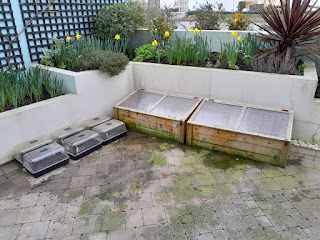Spring update
The evenings are getting longer, the daffodils are out (in the Isle of Man they are anyway, maybe not so much in Alaska) and gardeners’ thoughts start to turn to the year ahead. There isn’t a lot to photograph or write about right now as most annual seeds haven’t started to germinate and most perennials are coming out of their winter dormancy, but here is an update.
The above photograph shows two cold frames and six seed trays on my patio. I generally overwinter existing plants and start new plants off on my patio before transferring them to the allotment in late spring or early summer, because the allotment is actually quite a plant-hostile place. It is out in the countryside, it doesn’t benefit from the “heat island” effect of our small town, so the nights are colder and frostier. It’s more exposed to wind, which I have spoken about before: the strong, cold, salt-laden winds of the Isle of Man are enough to shrivel even the hardiest of plants. And it’s full of critters who are determined to eat my stuff, including (but not limited to) pigeons, pheasants, long-tails, slugs, snails, earwigs, rabbits and many more. So I like to keep my plants close at hand until they have grown bigger and hardier.
The seed trays on the left of the photo contain popcorn seeds. Although I write this blog about anaesthetic plants, I also grow normal edible plants on my allotment, including perennials like apples, strawberries, raspberries and red-and black-currants, and annuals like peas and popcorn.
This year I have a little experiment going with the popcorn. The seed packet (pictured above) says “Sow by July 2022 - Packeted 2021”. I am a little skeptical about this, because seeds usually last for more than one season. Does the germination rate really fall off this rapidly, or is the seed company just trying to scare me into buying more seeds? So I’ve planted one seed tray with the 2021 popcorn seeds and the other five trays with 2022 seeds to see if there is any difference in the germination rates. I’ll let you know the outcome in my next blog post.
Inside the left hand cold frame you can see that the wolfsbane (bottom left) and mandrake (top right) plants have already awakened from their winter dormancy and are putting out new leaves. No sign of life yet from the belladonna. My ambition this year is to grow one or more belladonna plants to their full height, which can be up to 6 feet tall in the right conditions. Observations from previous years suggest that the way to do this is to protect them from the wind (see above) until at least July. Again, I’ll let you know how I get on.
In the right hand cold frame you can see three white bryony (English mandrake) plants on the left which are already going like the clappers and trying to find a way out of the cold frame. These are the three plants which resulted from dividing the root of the one big plant which I wrote about in my last post in December.
And finally, an interesting development from the University of Cambridge, where a team of researchers is translating and making available online over 180 medieval manuscripts containing medical recipes: the "Curious Cures in Cambridge Libraries" project. You can read more about it here.
I’m hoping the results of this research will help me in my quest to make one or more working plant-based anaesthetics.
Next update in June.
Slaynt vie, bea veayn, beeal fliugh as baase ayns Mannin








Comments
Post a Comment